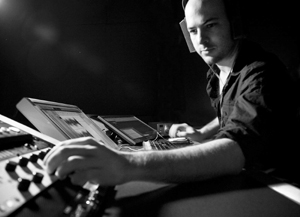Bushwick Buildout: The Sony Strain Lives on in Blackler Mastering
BUSHWICK, BROOKLYN: New York City still has its temples of mastering – Sterling Sound and Masterdisk among them. But one that’s gone and is still missed is Sony: The spirited mastering complex there hosted a dozen or so of the world’s top mastering engineers there at its peak.
Today, Sony Mastering is a memory, but its alumni – scattered throughout NYC and the world – continue to make an impact on the audio world. One of very last people to be promoted to full mastering engineer there was Kevin Blackler, who is now building on the Sony tradition in his Brooklyn-based practice. At Blackler Mastering, the expertise of the masters he learned from can be heard clearly in his work.

Kevin Blackler is flying this ship.
“I think I hear differently than most people,” says Blackler, whose recent credits include Prodigy, Paul Oakenfold, Plies, The Metropolitan Opera, The Hymns, and organ genius Joey DeFrancesco. “I’ve worked so hard to create a great listening environment at Blackler Mastering, because I’ve learned from the best. At Sony there were 12 different mastering rooms, 12 different engineers and 12 opinions. I was able to take something away from each one of them, and create my own recipe from all those flavors: One guy is all-digital, another is all-analog. No one else has the education that I got while I was there.”
On the border of the bohemian Brooklyn neighborhoods of Williamsburg and Bushwick, Blackler’s room matches the dimensions and elite gear choices of his suite at Sony, making him the go-to mastering engineer for the myriad local artists as well as international acts. Within his George Ausperger-designed mastering room, purchased directly from Sony Studios and transplanted to Brooklyn, are Custom Dunlavy SCIV monitors, Stax SRM 32311 Ear speakers, Massenburg Design Works MD3 EQ, and an Otari MX 50-50 tape machine.
“Being able to trust what you’re hearing is the essential element of mastering,” Blackler says. “Converters are one important part of the equation. My D/A’s are the first thing the music touches coming out of Pro Tools HD, and after my analog chain it’s back to the converters on the A/D side. The imaging that I get from my LavryBlue converters, for example, is a little bit wider, the upper mids are a little smoother, and they have a touch more bass presence than other converters I’ve heard. Although what I capture with it is extremely accurate, they have a smoothness and an EQ curve that’s apparent and natural.”
In the spirit of sharing, Blackler offers up a couple of choice mastering tips that he’s honed. “You have to figure out which bass frequencies will really help the music,” he notes. “For straight bass, 60 Hz and 80 Hz is where to look. If you want to get more bass and also raise the vocal level, 100 Hz is the perfect place to boost it. After the raise there, the area around 120 Hz and 220 Hz can get muddy, so I’ll cut around there to compensate.”
A mastering engineer who also makes the time to jam out live on keyboards with other musicians, Kevin Blackler loves nothing more than being immersed in music. “I like being engulfed in sound onstage,” he says. “When I’m in my mastering suite, I’ll close my eyes and imagine that people are performing the record in front of me.” – David Weiss
Please note: When you buy products through links on this page, we may earn an affiliate commission.






